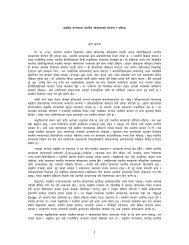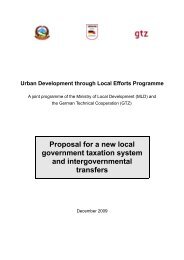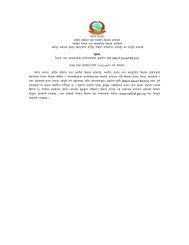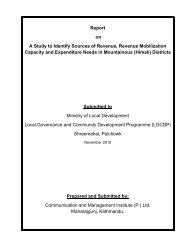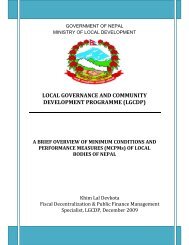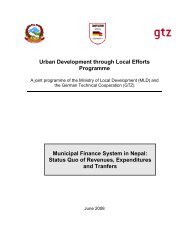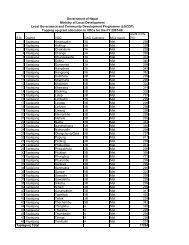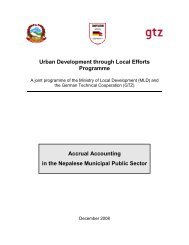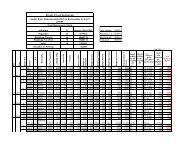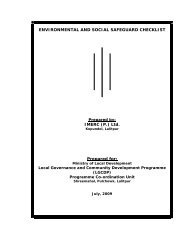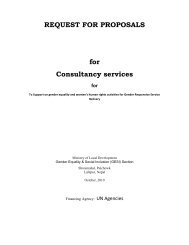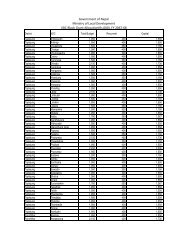GTZ Report on Guideline Asset Valuation - LGCDP
GTZ Report on Guideline Asset Valuation - LGCDP
GTZ Report on Guideline Asset Valuation - LGCDP
Create successful ePaper yourself
Turn your PDF publications into a flip-book with our unique Google optimized e-Paper software.
Urban Development through Local Efforts<br />
Programme<br />
A joint programme of the Ministry of Local Development (MLD) and<br />
the German Technical Cooperati<strong>on</strong> (<str<strong>on</strong>g>GTZ</str<strong>on</strong>g>)<br />
<strong>Guideline</strong>: <strong>Asset</strong> Valuati<strong>on</strong> for<br />
Municipal Fixed <strong>Asset</strong>s for Accrual<br />
Accounting in Nepalese Municipalities<br />
August 2009
Abbreviati<strong>on</strong>s and Acr<strong>on</strong>yms<br />
AAS Accrual Accounting System<br />
CSC Current Standard Cost (method)<br />
DRC Depreciated Replacement Cost<br />
DSC Deflated Standard Cost (method)<br />
GASB Governmental Accounting Standards Board India<br />
GAVP Generally Accepted Valuati<strong>on</strong> Principles<br />
<str<strong>on</strong>g>GTZ</str<strong>on</strong>g> German Technical Cooperati<strong>on</strong><br />
ICAI Chartered Accountants of India<br />
ICAN Institute of Chartered Accountants of Nepal<br />
IFAC Internati<strong>on</strong>al Federati<strong>on</strong> of Accountants<br />
IFRS Internati<strong>on</strong>al Financial <str<strong>on</strong>g>Report</str<strong>on</strong>g>ing Standards<br />
IPSAS Internati<strong>on</strong>al Public Sector Accounting Standards<br />
IPSASB Internati<strong>on</strong>al Public Sector Accounting Standards Board<br />
IVA Internati<strong>on</strong>al Valuati<strong>on</strong> Applicati<strong>on</strong><br />
IVS Internati<strong>on</strong>al Valuati<strong>on</strong> Standard<br />
LBFC Local Bodies Fiscal Commissi<strong>on</strong><br />
LSGA Local Self Governance Act 1999<br />
MLD Ministry for Local Development Nepal<br />
MoUD Ministry of Urban Development India<br />
MuAN Municipal Associati<strong>on</strong> of Nepal<br />
NMAM Nati<strong>on</strong>al Municipal Accounting Manual India<br />
NPSAS Nepal Public Sector Accounting Standards<br />
UDLE Urban Development through Local Efforts Programme<br />
ULB Urban Local Bodies India
Table of C<strong>on</strong>tents<br />
1. Introducti<strong>on</strong> ....................................................................................................................... 1<br />
1.1 Purpose ....................................................................................................................... 1<br />
1.2 Definiti<strong>on</strong>s .................................................................................................................... 1<br />
1.3 Classificati<strong>on</strong> of <strong>Asset</strong>s ................................................................................................ 3<br />
1.4 Status Quo in Nepalese Municipalities ......................................................................... 3<br />
2. Valuati<strong>on</strong> of <strong>Asset</strong>s – General Principles ........................................................................ 4<br />
2.1 Historical Cost .............................................................................................................. 4<br />
2.2 Borrowing Cost ............................................................................................................ 4<br />
2.3 Cost Model .................................................................................................................. 4<br />
2.4 Revaluati<strong>on</strong> Model ....................................................................................................... 4<br />
2.5 Valuati<strong>on</strong> Principles for Fixed <strong>Asset</strong>s ........................................................................... 5<br />
3. Valuati<strong>on</strong> of <strong>Asset</strong>s for Opening Balance Sheet ............................................................. 5<br />
3.1 Historical Cost Based Model ........................................................................................ 5<br />
3.2 Current Standard Cost Method .................................................................................... 6<br />
3.3 Estimated Current Standard Cost Method .................................................................... 6<br />
3.4 Case by Case Determinati<strong>on</strong> ....................................................................................... 6<br />
3.5 Depreciated Replacement Cost (DRC) ........................................................................ 7<br />
3.6 Valuati<strong>on</strong> of Land ......................................................................................................... 8<br />
3.7 Issues in Valuati<strong>on</strong> ....................................................................................................... 8<br />
4. Valuati<strong>on</strong> of <strong>Asset</strong>s – Ongoing ........................................................................................ 9<br />
4.1 Team Valuati<strong>on</strong> Committee .......................................................................................... 9<br />
4.2 Straight Line Method ...................................................................................................10<br />
4.3 Written Down Value Method .......................................................................................10<br />
4.4 Revaluati<strong>on</strong> of <strong>Asset</strong>s .................................................................................................10<br />
5. Legal Requirements .........................................................................................................11<br />
5.1 Local Self Government Act 1999 and Local Self Government Regulati<strong>on</strong>s .................11<br />
5.2 Internati<strong>on</strong>al Public Sector Accounting Standards .......................................................12<br />
6. Best Practice ....................................................................................................................14<br />
7. C<strong>on</strong>clusi<strong>on</strong> .......................................................................................................................15<br />
8. Annex ................................................................................................................................18<br />
9. References .......................................................................................................................20
Introducti<strong>on</strong> 1<br />
1. Introducti<strong>on</strong><br />
The Government of Nepal has decided to implement an Accrual Accounting System (AAS)<br />
<strong>on</strong> municipal level which is laid down in the Local Self Governance Act (LSGA). Up to now<br />
there exists no full-fledged accounting system for the public authorities and local bodies.<br />
<str<strong>on</strong>g>GTZ</str<strong>on</strong>g> was requested by MLD/LBFC to support the development and implementati<strong>on</strong> of a<br />
standardized AAS for the Nepalese municipalities. One prec<strong>on</strong>diti<strong>on</strong> for the full<br />
implementati<strong>on</strong> of AAS is a properly working <strong>Asset</strong> Valuati<strong>on</strong>.<br />
The following recommendati<strong>on</strong>s review the existing documentati<strong>on</strong> and status quo of asset<br />
valuati<strong>on</strong>, relevant legal requirements, internati<strong>on</strong>al best practices and experiences in some<br />
Nepalese municipalities.<br />
1.1 Purpose<br />
The valuati<strong>on</strong> of public sector assets may be undertaken for a range of purposes like<br />
financial reporting, privatizati<strong>on</strong> planning, loan originati<strong>on</strong>, b<strong>on</strong>d issuance, cost benefit or<br />
ec<strong>on</strong>omic analysis. Aim is to determine whether a public asset is being used and managed<br />
efficiently or to set pricing for m<strong>on</strong>opoly services.<br />
Main purpose of this guideline for asset valuati<strong>on</strong> is to serve the staff of local bodies to<br />
facilitate the valuati<strong>on</strong> of municipal assets in the course of preparati<strong>on</strong> of opening balance<br />
sheet, with the aim to:<br />
• Determine the appropriate value, useful life and depreciati<strong>on</strong> of municipal fixed assets,<br />
as well as the reporting in the financial statements<br />
• Increase the effectiveness of c<strong>on</strong>trol over fixed assets of the municipality<br />
• Help local bodies to present its true and fair financial positi<strong>on</strong>, budgetary planning and<br />
c<strong>on</strong>trol over resources<br />
Thus, this guideline for the municipalities should support them in the process of inventory<br />
and set up of an asset register, which is a prec<strong>on</strong>diti<strong>on</strong> for the implementati<strong>on</strong> of an AAS.<br />
1.2 Definiti<strong>on</strong>s<br />
C<strong>on</strong>sidering the frameworks and needs in Nepalese municipalities, this guideline focuses<br />
<strong>on</strong>ly <strong>on</strong> Capital <strong>Asset</strong>s, including intangible assets, fixed assets and financial assets. It<br />
does not deal with floating assets like stocks, receivables and liquid assets. As capital assets<br />
are most of the time the biggest share of municipal assets, they are focused <strong>on</strong> first.<br />
In the following secti<strong>on</strong> several terms will be defined, which are important in terms of working<br />
in the field of asset valuati<strong>on</strong>.<br />
The Internati<strong>on</strong>al Public Sector Accounting Standards Board (IPSASB) defines <strong>Asset</strong>s in its<br />
Public Sector Accounting Standards (IPSAS) as “resources c<strong>on</strong>trolled by an entity as a
Introducti<strong>on</strong> 2<br />
result of past events and from which future ec<strong>on</strong>omic benefits or service potential are<br />
expected to flow to the entity.” 1<br />
According to this definiti<strong>on</strong> <strong>on</strong> assets, the Internati<strong>on</strong>al Valuati<strong>on</strong> Standards Committee<br />
defines<br />
Public Sector <strong>Asset</strong>, as “an asset, owned and/ or c<strong>on</strong>trolled by a governmental or quasigovernmental<br />
entity, for the provisi<strong>on</strong> of some public service or good.” Different types of<br />
2<br />
assets can be described as public sector assets, such as c<strong>on</strong>venti<strong>on</strong>al assets, heritage and<br />
c<strong>on</strong>servati<strong>on</strong> assets, infrastructure assets, public utility plants, recreati<strong>on</strong>al assets and public<br />
buildings. Following the Internati<strong>on</strong>al Valuati<strong>on</strong> Applicati<strong>on</strong> (IVA) public sector assets<br />
include:<br />
• <strong>Asset</strong>s that are irreplaceable, n<strong>on</strong>-cash generating and provide goods without any<br />
market competiti<strong>on</strong><br />
• Land with sale or leasing restricti<strong>on</strong>s<br />
• Land designated for a specialized use that is not necessarily its best use<br />
Whereas Fixed <strong>Asset</strong>s are “assets held with the intenti<strong>on</strong> of being used for the purpose of<br />
producing or providing goods or services and is not held for sale in the normal course of<br />
business.” 3<br />
The Fair Market Value is the price that would emerge out of an agreement between<br />
knowledgeable and willing parties in an open and unrestricted market, who are fully informed<br />
and not under any compulsi<strong>on</strong> to transact.<br />
The Gross Book Value is the historical cost of a fixed asset in the books of account or<br />
financial statements. When this amount is given net of accumulated depreciati<strong>on</strong>, it is termed<br />
as net book value.<br />
The Useful Life of an asset is the period over which an asset is expected to be of use by an<br />
entity or the number of producti<strong>on</strong> units expected to be obtained from the asset by an entity.<br />
In Nepal the Office of the Auditor General has defined a list of the expected useful life for<br />
4<br />
municipal assets and their applicable depreciati<strong>on</strong> rate.<br />
1 Internati<strong>on</strong>al Federati<strong>on</strong> of Accounts, Internati<strong>on</strong>al Public Sector Accounting Standards Board: Internati<strong>on</strong>al<br />
Public Sector Accounting Standards 1, paragraph 7.<br />
2 Internati<strong>on</strong>al Valuati<strong>on</strong> Standards Committee: Exposure Draft of proposed internati<strong>on</strong>al valuati<strong>on</strong> applicati<strong>on</strong> –<br />
valuati<strong>on</strong> of public sector assets for financial reporting, p. 4.<br />
3 Government of India, Accounting Standard (AS) 10: Accounting for fixed <strong>Asset</strong>s, p. 98.<br />
4 Urban Development through Local Efforts Programme, German Technical Cooperati<strong>on</strong>: Inventory of Municipal<br />
Fixed <strong>Asset</strong>s and Development of a Fixed <strong>Asset</strong> Register, p. 14.
Introducti<strong>on</strong> 3<br />
1.3 Classificati<strong>on</strong> of <strong>Asset</strong>s<br />
A proposed categorizati<strong>on</strong> for Nepalese municipalities is a divisi<strong>on</strong> of assets into:<br />
Land<br />
Buildings<br />
Physical Infrastructure<br />
Movable <strong>Asset</strong>s<br />
Intangible <strong>Asset</strong>s<br />
parks, playgrounds, parking places,<br />
agricultural land, vacant site without<br />
c<strong>on</strong>structi<strong>on</strong><br />
office-buildings, schools, hospitals, fire<br />
stati<strong>on</strong>, town hall building<br />
roads and bridges, sewerage and drainage,<br />
public lighting, plant and machinery<br />
vehicles, furniture, fixtures, fittings and<br />
electrical appliances, office and other<br />
equipment<br />
IT-software<br />
Please refer to the UDLE report <strong>on</strong> “Inventory of municipal fixed assets and development of<br />
a fixed asset register“ (secti<strong>on</strong> 5.2) for further informati<strong>on</strong> <strong>on</strong> the classificati<strong>on</strong> of assets.<br />
1.4 Status Quo in Nepalese Municipalities<br />
In Kathmandu Metropolitan City asset valuati<strong>on</strong> is used since two years, but up to now it<br />
was not carried away annually. The old assets are already valued and new assets, for which<br />
price and age are known, have to be added <strong>on</strong> the balance sheet yet. No depreciati<strong>on</strong> is<br />
d<strong>on</strong>e, but a Chart of Accounts already exists, including depreciati<strong>on</strong> methods, a list of<br />
depreciati<strong>on</strong> rates and a balance sheet standard form c<strong>on</strong>taining the cost or value of<br />
assets. 5<br />
In Pokhara Sub-Metropolitan City asset valuati<strong>on</strong> has been introduced three years ago<br />
and they are using a Valuati<strong>on</strong> Committee c<strong>on</strong>sisting of seven experts from the public and<br />
private sector for the valuati<strong>on</strong>. Up to now they are using no depreciati<strong>on</strong> and are valuing the<br />
assets case by case.<br />
Butwal and Dharan Municipality are used to asset management, including depreciati<strong>on</strong>s<br />
and debt management. C<strong>on</strong>cerning the asset valuati<strong>on</strong> a committee was formed, but asset<br />
valuati<strong>on</strong> was not periodically updated due to the absence of local political representatives.<br />
Smaller Municipalities (e.g. Lekhnath, Byas) are still using the modified cash accounting<br />
system and therefore have not introduced a valuati<strong>on</strong> of assets yet.<br />
In the Proceeding <str<strong>on</strong>g>Report</str<strong>on</strong>g> of Informati<strong>on</strong> Sharing Programme <strong>on</strong> Corporate Accounting<br />
System for Nepalese municipalities <strong>on</strong> 23rd March 2009 it was stated by some<br />
municipalities, that asset valuati<strong>on</strong> has been <strong>on</strong>e of the most difficult parts in regards of AAS<br />
implementati<strong>on</strong>. For simplifying this process the following guidelines should be of help to the<br />
municipalities.<br />
5 Kathmandu Metropolitan City: Chart of Accounts, p. 25-27.
Valuati<strong>on</strong> of <strong>Asset</strong>s – General Principles 4<br />
2. Valuati<strong>on</strong> of <strong>Asset</strong>s – General Principles<br />
Underlying assumpti<strong>on</strong> of the following paragraphs is that investment (e.g. maintenance<br />
costs) d<strong>on</strong>e by the municipality serves the purpose of public service delivery, it should not<br />
have a pure commercial functi<strong>on</strong>.<br />
2.1 Historical Cost<br />
Historical cost of an asset do not <strong>on</strong>ly include the purchase price or c<strong>on</strong>structi<strong>on</strong> cost, but<br />
also costs for placing the asset in its intended locati<strong>on</strong> and c<strong>on</strong>diti<strong>on</strong> for use, like import<br />
duties, transportati<strong>on</strong> cost, cost of site preparati<strong>on</strong>, installati<strong>on</strong> cost and professi<strong>on</strong>al fees for<br />
engineers or architects.<br />
In case the local body is c<strong>on</strong>structing the asset itself, the c<strong>on</strong>structi<strong>on</strong> and any c<strong>on</strong>structi<strong>on</strong>related<br />
cost should be taken into account when valuing the asset.<br />
2.2 Borrowing Cost<br />
Borrowing cost (e.g. interest <strong>on</strong> loan) are developing when outlays for the asset incur, this is<br />
valid for assets that necessarily take a substantial period of time to get ready for the<br />
intended use. If the borrowing costs are directly attributable to the acquisiti<strong>on</strong>, c<strong>on</strong>structi<strong>on</strong><br />
or producti<strong>on</strong> of a qualifying asset, they can be capitalized as part of the asset’s costs. 6<br />
2.3 Cost Model<br />
The Cost Model requires that, “after recogniti<strong>on</strong> as an asset, an item of property, plant and<br />
equipment shall be carried at its cost less any accumulated depreciati<strong>on</strong> and any<br />
accumulated impairment losses.” 7<br />
2.4 Revaluati<strong>on</strong> Model<br />
The Revaluati<strong>on</strong> Model ensures that the valuati<strong>on</strong> of assets is c<strong>on</strong>tinually reviewed to reflect<br />
the fair market value (see definiti<strong>on</strong> in secti<strong>on</strong> 1.2). In the IPSAS the Revaluati<strong>on</strong> Model is<br />
described as follows:<br />
“After recogniti<strong>on</strong> as an asset, an item of property, plant and equipment whose fair value can<br />
be measured reliably shall be carried at a revalued amount, being its fair value at the date of<br />
the revaluati<strong>on</strong> less any subsequent accumulated depreciati<strong>on</strong> and subsequent accumulated<br />
impairment losses.” 8<br />
The fair value of the item can be usually determined from market-based evidence (by<br />
appraisal).<br />
If the asset has no market value, the fair value of the item can be assessed by reference to a<br />
similar item c<strong>on</strong>cerning character, locati<strong>on</strong> and circumstances.<br />
6 Government of India, Ministry of Urban Development: Model Nati<strong>on</strong>al Municipal <strong>Asset</strong> Valuati<strong>on</strong> Methodology<br />
Manual, p. 14-15.<br />
7 Internati<strong>on</strong>al Federati<strong>on</strong> of Accounts, Internati<strong>on</strong>al Public Sector Accounting Standards Board: Internati<strong>on</strong>al<br />
Public Sector Accounting Standards 17, paragraph 43.<br />
8 Ibid, paragraph 44.
Valuati<strong>on</strong> of <strong>Asset</strong>s for Opening Balance Sheet 5<br />
2.5 Valuati<strong>on</strong> Principles for Fixed <strong>Asset</strong>s<br />
• Fixed assets should be valued at historical cost paid to purchase them, which is the<br />
most stable, reliable and secure method of valuati<strong>on</strong><br />
• Fixed assets, for which no payment has been made, should be recorded at nominal<br />
value (reminder value of assets) of 1 NPR. This does NOT mean that the maintenance<br />
costs of such assets are lower than maintenance costs of assets, for which it has been<br />
paid for<br />
• Depreciati<strong>on</strong>s should be made periodically to know the written down value of the asset<br />
Revaluati<strong>on</strong> is permitted and useful under special circumstances, for further informati<strong>on</strong><br />
please refer to secti<strong>on</strong> 4.4.<br />
The valuati<strong>on</strong> process should begin when the first opening balance sheet is prepared and<br />
when annual financial statements are being prepared.<br />
3. Valuati<strong>on</strong> of <strong>Asset</strong>s for Opening Balance Sheet<br />
There are several existing rules which should be applied when valuing assets for opening<br />
balance sheet:<br />
3.1 Historical Cost Based Model<br />
• If the asset was received as a gift or for free, the asset should be valued at a<br />
reminder value of 1 NPR. This has no impact <strong>on</strong> the amount of maintenance costs to<br />
be paid, which is the same for paid and unpaid assets.<br />
• If the cost of the asset and the date of purchase or c<strong>on</strong>structi<strong>on</strong> are known or<br />
available, the Historical Cost Based Model should be used.<br />
Historical Cost Based Model<br />
• Determine the historical cost of purchase or producti<strong>on</strong><br />
• Identify the depreciati<strong>on</strong> from date of purchase until the valuati<strong>on</strong> date<br />
• Deduct the depreciati<strong>on</strong> from the historical cost to get the book value <strong>on</strong> the date of<br />
valuati<strong>on</strong><br />
The historic approach is often referred to as a more objective approach, because it is based<br />
<strong>on</strong> the amount actually paid for the asset and it is easy to handle.<br />
On the other hand it is claimed that the values are out of date when a l<strong>on</strong>g time passed by<br />
since the original acquisiti<strong>on</strong> and that inc<strong>on</strong>sistencies in the treatment between and within<br />
entities exists. If the records are insufficient, the original acquisiti<strong>on</strong> costs could not even be<br />
known.<br />
For the valuati<strong>on</strong> of assets, the Historical Cost Based Approach should be used, because it is<br />
the closest <strong>on</strong>e can get to the historical cost of the asset. All of the following methods are<br />
improvisati<strong>on</strong>s to overcome deficient informati<strong>on</strong> about the existing assets.
Valuati<strong>on</strong> of <strong>Asset</strong>s for Opening Balance Sheet 6<br />
3.2 Current Standard Cost Method<br />
The now following methods are to be used, when there is deficient informati<strong>on</strong> about existing<br />
assets:<br />
• If the cost of the asset is not available, but the date of purchase or c<strong>on</strong>structi<strong>on</strong>, it<br />
has to be figured out, if the asset is bey<strong>on</strong>d useful life or not.<br />
• If the asset is bey<strong>on</strong>d useful life, it should be valued at a reminder value of 1 NPR.<br />
• If the asset is not bey<strong>on</strong>d useful life, it is necessary to estimate the current book<br />
value of the asset. One standardized valuati<strong>on</strong> to do this estimati<strong>on</strong> is the Current<br />
Standard Cost (CSC) method. Under the CSC method <strong>on</strong>e estimates the current cost<br />
of the asset <strong>on</strong> the date of valuati<strong>on</strong> at which similar or equivalent (new) assets can<br />
be purchased or c<strong>on</strong>structed. The current cost should be estimated in appropriate<br />
units of measurement, such as sq meters or running meters.<br />
However this method requires that a standard list is available that determines the<br />
costs of an asset in the specific measurements.<br />
A list of CSC is provided by the Government of Nepal.<br />
Current Standard Cost Method<br />
• Collect informati<strong>on</strong> about the asset<br />
• Categorize to appropriate head in the CSC list or use the most similar category<br />
possible<br />
• Calculate the CSC by multiplying the quantity with the individual price for <strong>on</strong>e unit of<br />
measurement (price of the asset <strong>on</strong> date of valuati<strong>on</strong>)<br />
• Deflate the price to the year of purchase of the asset, use the standard list of Deflated<br />
Standard Cost (DSC)<br />
• Calculate depreciati<strong>on</strong> from the date of purchase until the date of valuati<strong>on</strong><br />
3.3 Estimated Current Standard Cost Method<br />
If the costs of the asset are known, but the year of purchase or c<strong>on</strong>structi<strong>on</strong> cannot<br />
be estimated, <strong>on</strong>e should use the Estimated Current Standard Cost Method.<br />
The Estimated Current Standard Cost method follows the same scheme as the CSC,<br />
but before calculating the CSC it is essential to estimate the year of purchase.<br />
The estimati<strong>on</strong> of the year of purchase is a subjective method and it is permitted to<br />
estimate the age of the asset in ranges from 10-15 years.<br />
3.4 Case by Case Determinati<strong>on</strong><br />
• If as well the cost of the asset and the date of purchase or c<strong>on</strong>structi<strong>on</strong> are not<br />
known, the Case by Case Determinati<strong>on</strong> should be used.<br />
• Again, as first thing, it has to be examined if the useful life of the asset is over, then it<br />
should be valued at a reminder value of 1 NPR.
Valuati<strong>on</strong> of <strong>Asset</strong>s for Opening Balance Sheet 7<br />
• If the useful life of the asset is not over, the book value of the asset should be<br />
determined by members of a municipal valuati<strong>on</strong> team (for further informati<strong>on</strong> see<br />
secti<strong>on</strong> 4.1). The problem about this process is, that it requires a lot of resources and<br />
tends to get highly political, so attenti<strong>on</strong> should be paid to ensure a transparent<br />
valuati<strong>on</strong> process.<br />
• In this case use the rate of the asset similar in characteristics or properties to be able<br />
to calculate the value of the asset with the deficient informati<strong>on</strong>.<br />
Case by Case Determinati<strong>on</strong><br />
Aim is to determine the book value of the asset, by<br />
• The valuati<strong>on</strong> by a municipal valuati<strong>on</strong> team<br />
• Referring to other assets with same characteristics or properties<br />
3.5 Depreciated Replacement Cost (DRC)<br />
• With the help of this approach, the present value of the remaining useful<br />
life/remaining service potential of an asset is determined as the DRC of the asset.<br />
Thus, the replacement cost is replacing the asset’s gross service potential.<br />
• These replacement costs are depreciated, so that they mirror the asset in its used<br />
c<strong>on</strong>diti<strong>on</strong>. Another process of replacement is by reproducti<strong>on</strong> (replicati<strong>on</strong>) of the<br />
existing asset.<br />
• The DRC can be described as the current cost of reproducti<strong>on</strong>/replacement of <strong>on</strong>e<br />
asset minus the deducti<strong>on</strong>s for deteriorati<strong>on</strong> and forms of obsolescence and<br />
optimizati<strong>on</strong>. Obsolescence means a loss in value that is the result of a decrease of<br />
usefulness of property, this can be due to decay, changes in technology,<br />
envir<strong>on</strong>mental or user demand changes, whereas an optimizati<strong>on</strong> determines a least<br />
cost replacement for the remaining service potential of the asset.<br />
So most of the times the optimizati<strong>on</strong> minimizes the valuati<strong>on</strong> where as well<br />
alternative lower cost replacements are available. 9<br />
Overview:<br />
If the asset was received as a gift value at 1 NRP<br />
If the asset was purchased/c<strong>on</strong>structed<br />
Both cost and date available Historical Cost Based Method<br />
No cost, but date available Current Standard Cost Method<br />
Neither cost nor date<br />
No estimati<strong>on</strong> of the date possible Case to Case Basis<br />
Estimati<strong>on</strong> of the date possible Estimated Current Standard Cost<br />
Method/Depreciated Replacement Cost<br />
Please refer to Annex 1 for a flowchart for the valuati<strong>on</strong> of Fixed <strong>Asset</strong>s.<br />
9 Internati<strong>on</strong>al Valuati<strong>on</strong> Standards Committee: Exposure Draft of proposed internati<strong>on</strong>al valuati<strong>on</strong> applicati<strong>on</strong> –<br />
valuati<strong>on</strong> of public sector assets for financial reporting, p. 14.
Valuati<strong>on</strong> of <strong>Asset</strong>s for Opening Balance Sheet 8<br />
3.6 Valuati<strong>on</strong> of Land<br />
For the valuati<strong>on</strong> of land <strong>on</strong>e of the following opti<strong>on</strong>s should be chosen:<br />
• To set the value of land, the valuati<strong>on</strong> committee can corresp<strong>on</strong>d to the minimum<br />
value set by the Land Revenue Office (for the purpose of land transacti<strong>on</strong>).<br />
• Otherwise the valuati<strong>on</strong> committee can refer to the prevailing market value, the type<br />
of road access or rental value, to name some examples.<br />
• Another method is to use the minimum and maximum valuati<strong>on</strong> rates, which are<br />
proposed by the ward level committees. 10<br />
3.7 Issues in Valuati<strong>on</strong><br />
In the first place there are existing problems c<strong>on</strong>cerning the use of the Current Standard<br />
Cost Method, because some assets do not have prescribed CSC. Other possibilities to<br />
value these assets are to c<strong>on</strong>sider the recent purchase cost for similar assets. Afterwards<br />
<strong>on</strong>e has to depreciate to arrive at current book value.<br />
Valuing Capital Work in Progress is another difficulty, the costs for the capital work in<br />
progress should be known <strong>on</strong> the date of the opening balance sheet, so the informati<strong>on</strong> has<br />
to be drawn from the records (e.g. Bills Register, Grants Register). Then the amounts have<br />
to be booked according to the gross amount of bills received by the municipality. Borrowing<br />
costs should as well be included.<br />
Another difficulty is the valuati<strong>on</strong> of Intangible <strong>Asset</strong>s. Generally intangible assets are in the<br />
nature of expenditure <strong>on</strong> software. The process of valuati<strong>on</strong> can differ:<br />
• If purchased, the costs of the asset include the purchase price, import duties and<br />
other directly attributable expenditure, but it is important to deduct any trade<br />
discounts and rebates.<br />
• If internally generated (assets should be recognized as internally generated if they<br />
will bring future ec<strong>on</strong>omic benefit 11 ), the costs include every expenditure that is<br />
directly related to the creati<strong>on</strong> of the asset, e.g. expenditure <strong>on</strong> materials and<br />
services used in developing the asset, salaries and wages, but expenditures like<br />
administrative fees, operating losses and training the staff should be excluded.<br />
• If gifted/d<strong>on</strong>ated, the asset should be valued at 1 NPR (reminder value).<br />
• If acquired through exchange, the asset is exchanged for an old intangible asset. If<br />
the assets are similar, the net book value of the exchanged asset should be taken<br />
into account and any extra paid amount be added (or if a refund is involved,<br />
necessary adjustments need to be d<strong>on</strong>e). For dissimilar assets the asset should be<br />
recognized at its fair value.<br />
10 Ibid, p. 22.<br />
11 Accounting Standards 26, in: Government of India, Ministry of Urban Development: Model Nati<strong>on</strong>al Municipal<br />
<strong>Asset</strong> Valuati<strong>on</strong> Methodology Manual, p. 42.
Valuati<strong>on</strong> of <strong>Asset</strong>s – Ongoing 9<br />
As well for Heritage <strong>Asset</strong>s special valuati<strong>on</strong> rules should be applied, because the cultural,<br />
envir<strong>on</strong>mental, educati<strong>on</strong>al and historic value or importance is probably not fully reflected in<br />
a financial value that is based <strong>on</strong> the market price. They have l<strong>on</strong>g life cycles and their value<br />
does not diminish over time due to wear and tear, instead they are more likely to increase in<br />
value over time. Heritage assets include historical buildings and m<strong>on</strong>uments, archaeological<br />
sites, c<strong>on</strong>servati<strong>on</strong> areas and nature reserves. 12<br />
• For the valuati<strong>on</strong> of heritage assets, the valuati<strong>on</strong> committee should work case by<br />
case.<br />
• Only when the historic nature of the property itself is c<strong>on</strong>tributing to the provided<br />
service, the cost of reproducing the asset can be reflected in the cost of the modern<br />
equivalent (except the case that the original historic significance cannot be<br />
recreated). 13<br />
Valuati<strong>on</strong> requirements for Leased <strong>Asset</strong>s are laid down in IPSAS 13. Please refer to<br />
Secti<strong>on</strong> 5 – Legal Requirements for further informati<strong>on</strong>.<br />
• The fair value of the asset is needed to establish the cost of the asset, which is then<br />
recorded by the entity <strong>on</strong> the balance sheet.<br />
4. Valuati<strong>on</strong> of <strong>Asset</strong>s – Ongoing<br />
When the asset has been valued and reported into the balance sheet, the carrying value<br />
needs to be periodically depreciated.<br />
The depreciati<strong>on</strong> rates are given by the state, in Nepal a list of depreciati<strong>on</strong> rates is provided<br />
by the Office of the Auditor General. All fixed assets have to be depreciated c<strong>on</strong>sistently <strong>on</strong><br />
either Straight Line Method or Written down Value Method.<br />
4.1 Team Valuati<strong>on</strong> Committee<br />
Following rule 144 (3) of the Local Self Governance Regulati<strong>on</strong> a valuati<strong>on</strong> committee is<br />
supposed to be formed for the valuati<strong>on</strong> of assets. The members of a municipal valuati<strong>on</strong><br />
committee have to be appointed by the municipal steering committee. This valuati<strong>on</strong><br />
committee should c<strong>on</strong>sist of municipal accounting experts and external engineers.<br />
In advance of the actual valuati<strong>on</strong> process they are asked to prepare a work plan, so that the<br />
type of informati<strong>on</strong> to be collected and the format of forms and notices are already known at<br />
a preliminary stage. 14<br />
12 Internati<strong>on</strong>al Valuati<strong>on</strong> Standards Committee: Exposure Draft of proposed internati<strong>on</strong>al valuati<strong>on</strong> applicati<strong>on</strong> –<br />
valuati<strong>on</strong> of public sector assets for financial reporting, p. 6.<br />
13 Government United Kingdom, Royal Instituti<strong>on</strong> of Chartered Surveyors, Public Sector Valuati<strong>on</strong> Group:<br />
Guidance <strong>on</strong> <strong>Asset</strong> Valuati<strong>on</strong>, 1.19-1.23.<br />
14 Municipal Associati<strong>on</strong> of Nepal: Municipal Integrated Property Tax Management Manual, Exposure Draft,<br />
p. 21.
Valuati<strong>on</strong> of <strong>Asset</strong>s – Ongoing 10<br />
4.2 Straight Line Method<br />
Straight line depreciati<strong>on</strong> is the most simple and most often used technique. This method<br />
uses the date of purchase of the asset as starting point and subtracts the approximate<br />
salvage value. The resulting amount is then divided by the useful life of the asset:<br />
Purchase date of the asset – Approximate salvage value<br />
Useful life of the asset<br />
As result <strong>on</strong>e gets the depreciati<strong>on</strong> charge, which the municipality employs annually for <strong>on</strong>e<br />
specific asset.<br />
All in all the Straight Line Method is recommendable for the depreciati<strong>on</strong> process of<br />
municipalities, which do not have a l<strong>on</strong>g going experience with the depreciati<strong>on</strong> of assets.<br />
4.3 Written Down Value Method<br />
This method accelerates depreciati<strong>on</strong> because it recognizes a higher depreciati<strong>on</strong> cost<br />
earlier in the asset’s lifetime. Like that, each year’s depreciati<strong>on</strong> is applied to the opening net<br />
book value of the asset and not to the original cost of the asset. This process is <strong>on</strong>going until<br />
the residual or salvage value or the end of the asset’s useful life is reached.<br />
If the fixed percentage depreciati<strong>on</strong> rate would be 15 percent per year, the asset will be<br />
depreciated by 15 percent of its historic cost in the first year. The following year, the asset<br />
will again be depreciated by 15 percent, but not from its historic cost, but from the already<br />
depreciated value of the asset.<br />
The Written Down Value Method is especially important for the private sector, because it is<br />
better displaying the market value of assets, while for the municipalities the market value is<br />
of minor importance.<br />
4.4 Revaluati<strong>on</strong> of <strong>Asset</strong>s<br />
The recommended policies differ between an increasing or decreasing net book value.<br />
• If an increase in net book value is taking place, the proposal is to credit the increase<br />
<strong>on</strong> revaluati<strong>on</strong> to a “revaluati<strong>on</strong> reserve account”.<br />
• If a decrease in net book value is taking place, it can be charged to the income and<br />
expenditure account, except from the case, that the decrease is related to a previous<br />
increase in revaluati<strong>on</strong>. Then it should be treated like an increase in net book value.<br />
• If <strong>on</strong>e single asset is revalued, the entire category (e.g. land, buildings, vehicles) to<br />
which the asset bel<strong>on</strong>gs has to be revalued.<br />
• Attenti<strong>on</strong> has to be paid that the net book value after a revaluati<strong>on</strong> of a class of<br />
assets is not greater than the recoverable amount of this class’s assets itself.<br />
• The revaluati<strong>on</strong> reserve can be reduced by depreciati<strong>on</strong> and charged <strong>on</strong> the revalued<br />
asset.
Legal Requirements 11<br />
5. Legal Requirements<br />
For the case of Nepal the legal requirements given in the LSGA from 1999 and its’<br />
Regulati<strong>on</strong>s and in the IPSAS are to be taken into account.<br />
5.1 Local Self Government Act 1999 and Local Self Government Regulati<strong>on</strong>s<br />
The problem c<strong>on</strong>cerning the valuati<strong>on</strong> of assets is that the property rights of specific<br />
municipal assets are not always clearly stated or have to be legally binding. The LSGA<br />
defines the property rights of municipal assets in Secti<strong>on</strong> 134 as follows:<br />
“(1) The Municipality shall have title over the following properties situated within the area of the<br />
Municipality, and the Municipality shall have to supervise, repair, maintain and manage such<br />
properties:<br />
(a) Properties c<strong>on</strong>structed and purchased from the fund of the Municipality or granted to it by<br />
His Majesty’s Government or any organizati<strong>on</strong> or individual.<br />
(b) Public properties not subject to any proprietary right of any individual and not within the<br />
c<strong>on</strong>trol of His Majesty’s Government or District Development Committee, such as public<br />
drainage, sewerage, bridges, p<strong>on</strong>ds, temples, public rest houses, inns, houses, water<br />
springs, water-spouts, wells, grazing, fields, outlets, courtyards, alleys, roads, paths and<br />
trees <strong>on</strong> either side of the roads.<br />
(c) The houses, land, parks, gardens, bus-parks etc. under the ownership of the Municipality.<br />
(d) Forests according to the prevailing forest laws or handed over by His Majesty’s<br />
Government.<br />
(e) Natural heritages.<br />
(2) The Municipality shall not be allowed to sell and dispose of or otherwise relinquish its title and<br />
possessi<strong>on</strong> <strong>on</strong> the properties as referred to in sub-secti<strong>on</strong> (1) without the approval of His Majesty’s<br />
Government. […]”<br />
The vagueness of the LSGA when describing property rights <strong>on</strong> certain assets leads to an<br />
<strong>on</strong>going c<strong>on</strong>fusi<strong>on</strong> in the municipalities if the asset bel<strong>on</strong>gs to the nati<strong>on</strong>al government or to the<br />
municipality. After different assets are identified by the municipality, more legal documents must<br />
be provided to the municipalities so that they can legally claim their property or there must be<br />
another legal procedure identifying property.<br />
The Local Self Government Regulati<strong>on</strong>s c<strong>on</strong>tain an important legal framework:<br />
• Rule 144 (3) <strong>on</strong> the provisi<strong>on</strong> of a Valuati<strong>on</strong> Committee<br />
• Rule 144 (5) Secti<strong>on</strong> A <strong>on</strong> the set of value of structure and methods by the Valuati<strong>on</strong><br />
Committee <strong>on</strong> the basis of the prevailing market values 15<br />
15 Government of Nepal, Ministry of Local Development: Local Self Government Regulati<strong>on</strong>, 1999, rule 144.
Legal Requirements 12<br />
5.2 Internati<strong>on</strong>al Public Sector Accounting Standards<br />
The IPSAS are developed by the Public Sector Committee of the Internati<strong>on</strong>al Federati<strong>on</strong> of<br />
Accountants (IFAC), which is the internati<strong>on</strong>al professi<strong>on</strong>al body of the accountancy<br />
professi<strong>on</strong>.<br />
The most important valuati<strong>on</strong> requirements can be found under IPSAS 17 – Property, Plant and<br />
Equipment and IPSAS 21 – Impairment of N<strong>on</strong>-Cash-Generating <strong>Asset</strong>s. But as well IPSAS 13<br />
– Leases and IPSAS 16 – Investment Property c<strong>on</strong>tain some legal requirements for the<br />
valuati<strong>on</strong> process. 1<br />
The IPSAS and their counterpart in the private sector, IFRS, adopt two models for the<br />
recogniti<strong>on</strong> of property assets in the balance sheet, the first is the cost model and the other<br />
<strong>on</strong>e the revaluati<strong>on</strong> model.<br />
IPSAS 17, paragraph 43, deals with the cost model, while paragraph 44 deals with the<br />
revaluati<strong>on</strong> model (both models can be found in secti<strong>on</strong> 2, paragraph 2.2 and 2.3)<br />
The assets are included in the balance sheet as follows:<br />
• “The fair value of items of property is usually determined from market-based<br />
evidence by appraisal. The fair value of items of plant and equipment is usually their<br />
market value determined by appraisal.” 16<br />
• “If no market evidence is available to determine the market value in an active and<br />
liquid market, the fair value of the item may be established by reference to other<br />
items with similar characteristics, in similar circumstances and locati<strong>on</strong>…” 17<br />
• “If there is no market-based evidence of fair value because of the specialized nature<br />
of the item of plant and equipment, an entity may need to estimate fair value…using<br />
depreciated replacement cost (see secti<strong>on</strong> 3.6) or the restorati<strong>on</strong> cost or service units<br />
approaches” (further informati<strong>on</strong> under IPSAS 21).<br />
As proposed by the Internati<strong>on</strong>al Valuati<strong>on</strong> Standards Committee, a Professi<strong>on</strong>al Valuer<br />
should be resp<strong>on</strong>sible for the appraisal and as well for the report of the market value of the<br />
assets.<br />
After IPSAS 17, paragraph 92, the Valuati<strong>on</strong> <str<strong>on</strong>g>Report</str<strong>on</strong>g> has to c<strong>on</strong>tain specific informati<strong>on</strong>:<br />
• The effective date of revaluati<strong>on</strong><br />
• Whether an independent valuer was involved<br />
• The methods applied and significant assumpti<strong>on</strong>s made<br />
• The extent to which the asset’s fair values were determined directly by reference to<br />
observable prices in an active market or were estimated using other valuati<strong>on</strong><br />
techniques<br />
The valuer has to ensure, that reports include these informati<strong>on</strong> to meet the requirements.<br />
16 Internati<strong>on</strong>al Federati<strong>on</strong> of Accounts, Internati<strong>on</strong>al Public Sector Accounting Standards Board: Internati<strong>on</strong>al<br />
Public Sector Accounting Standards 17, paragraph 45.<br />
17 Ibid, paragraph 47.
Legal Requirements 13<br />
IPSAS 21 deals with the valuati<strong>on</strong> of Impaired N<strong>on</strong>-Cash Generating <strong>Asset</strong>s. It defines<br />
impairment as the permanent decrease in the recoverable service amount of an asset that is<br />
below its carrying amount. In IPSAS 21, paragraph 48 it is stated that the carrying amount of<br />
the asset should be reduced to its recoverable service amount, if the recoverable service<br />
amount of an asset is smaller than its carrying amount (impairment loss).<br />
If the amount for such an impairment loss exceeds the carrying amount of the asset, the<br />
entity has to accept a liability. It is the task of the entity to write down the carrying amount of<br />
the impaired cash-generating assets to the higher of their value in use or fair value less the<br />
cost to sell. 18<br />
A special rule has to be applied to Surplus <strong>Asset</strong>s, because they should be separately<br />
identified, e.g. as “disposal group”. The assets are disposed of by sale or otherwise and the<br />
liabilities associated with these assets will be transferred into the transacti<strong>on</strong>.<br />
They have to be accounted for at the lower of the carrying amount and the fair value less<br />
cost to sell.<br />
The valuers have to decide whether the assets are to be valued individually or as a group<br />
that will be disposed of in a single transacti<strong>on</strong>.<br />
Aim is to determine the value in use (the asset’s remaining service potential) by <strong>on</strong>e of the<br />
approaches in paragraphs 41 to 45 in IPSAS 21:<br />
• Depreciated Replacement Cost Approach<br />
Often the depreciated replacement cost can be detected by referring to buying prices<br />
of assets with a similar service potential in an active and liquid market. Sometimes an<br />
asset’s reproducti<strong>on</strong> cost will be the best indicator of its replacement cost.<br />
For detailed informati<strong>on</strong> please refer to secti<strong>on</strong> 3.6.<br />
• Restorati<strong>on</strong> Cost Approach<br />
Restorati<strong>on</strong> costs are defined as costs of retracting the service potential of the<br />
individual asset to its pre-impaired level. To get the present value of the remaining<br />
service potential <strong>on</strong>e has to subtract the estimated restorati<strong>on</strong> cost of the asset from<br />
the current cost of replacing the remaining service potential before any impairment<br />
(depreciated reproducti<strong>on</strong> or replacement cost). 19<br />
• Service Units Approach<br />
The present value of the remaining service potential of the asset is determined by<br />
reducing the current cost of the remaining service potential before any impairment to<br />
be c<strong>on</strong>sistent with the reduced number of service units in the impaired state. The<br />
current cost of replacing the remaining service potential before impairment is<br />
identified as depreciated reproducti<strong>on</strong> or replacement cost, like in the Restorati<strong>on</strong><br />
Cost Approach. 20<br />
18 Internati<strong>on</strong>al Valuati<strong>on</strong> Standards Committee: Exposure Draft of proposed internati<strong>on</strong>al valuati<strong>on</strong> applicati<strong>on</strong> –<br />
valuati<strong>on</strong> of public sector assets for financial reporting, p. 10.<br />
19 Internati<strong>on</strong>al Federati<strong>on</strong> of Accounts, Internati<strong>on</strong>al Public Sector Accounting Standards Board: Internati<strong>on</strong>al<br />
Public Sector Accounting Standards 21, paragraph 44.<br />
20 Ibid, paragraph 45.
Best Practice 14<br />
IPSAS 16 are about valuati<strong>on</strong>s c<strong>on</strong>cerning Investment Property and all public sector<br />
investment property has to be valued in accordance with these standards.<br />
IPSAS 13 present the valuati<strong>on</strong> requirements for Leased <strong>Asset</strong>s.<br />
For finance leases, the fair value of the asset is needed to establish the cost of the asset and<br />
liability and to report it <strong>on</strong> the balance sheet. For leases of land and buildings (other than<br />
investment property), they have to be classified separately as a finance lease or an<br />
operating lease. In each case the faire value of the leased asset has to be established. 21<br />
The Nepal Public Sector Accounting Standards (NPSAS) have been developed in<br />
accordance with the IPSAS and are still in their draft at the moment. They display the<br />
financial reporting under the cash basis of accounting. Part 2 of the NPSAS c<strong>on</strong>tains<br />
definiti<strong>on</strong>s of assets, the disclosure of assets and the reference to the related IPSAS 13 and<br />
17. Nevertheless, standards for asset valuati<strong>on</strong> are up to now not included in the NPSAS.<br />
6. Best Practice<br />
In order to create a best practice for asset valuati<strong>on</strong> in the public sector it might be useful to<br />
c<strong>on</strong>sider the situati<strong>on</strong> in other countries or methods used by the private sector in Nepal.<br />
Another important approach is the try to create Generally Accepted Valuati<strong>on</strong> Principles<br />
(GAVP) or Internati<strong>on</strong>al Valuati<strong>on</strong> Standards (IVS) which then would be used all over the<br />
world.<br />
Up to now, the implementati<strong>on</strong> of such internati<strong>on</strong>al principles or standards in the public<br />
sector has not shown much progress.<br />
One country, where several acti<strong>on</strong>s towards an asset valuati<strong>on</strong> in the public sector have<br />
been started, is India.<br />
Since 2003, the Municipal Corporati<strong>on</strong> of Delhi forced the urban governments to implement<br />
accrual accounting. Up to now Tamil Nadu, Maharashtra, Uttar Pradesh and Kamataka are<br />
federal states introducing accrual based accounting.<br />
In India the Ministry of Urban Development (MoUD) launched several initiatives towards<br />
good urban governance and local self government.<br />
After the Ministry introduced the Nati<strong>on</strong>al Municipal Accounting Manual (NMAM) (chapter 21,<br />
fixed assets), it now developed a Model Nati<strong>on</strong>al <strong>Asset</strong> Valuati<strong>on</strong> Methodology Manual,<br />
which should be used by Urban Local Bodies (ULB) for the valuati<strong>on</strong> of their assets and for<br />
the reporting of financial statements. The manual is based <strong>on</strong> the existing methodologies<br />
and bases used across India for determining the value of municipal assets and as well <strong>on</strong><br />
the valuati<strong>on</strong> methodology recommended by the IVS of the Internati<strong>on</strong>al Valuati<strong>on</strong><br />
Standards Committee.<br />
While the Office of the Comptroller and Auditor General of India have overseen the project, it<br />
was supported by Indo-USAID FIRE-D Project and the Nati<strong>on</strong>al Institute for Urban Affairs.<br />
21 Internati<strong>on</strong>al Valuati<strong>on</strong> Standards Committee: Exposure Draft of proposed internati<strong>on</strong>al valuati<strong>on</strong> applicati<strong>on</strong> –<br />
valuati<strong>on</strong> of public sector assets for financial reporting, p. 10.
C<strong>on</strong>clusi<strong>on</strong> 15<br />
The Government of India as well released accounting standards issued by the Institute of<br />
Chartered Accountants of India (ICAI) and Accounting Principles stated in the NMAM.<br />
Delhi, Bangalore and some other ULB use the Statements issued by the Governmental<br />
Accounting Standards Board (GASB) of the USA. Especially GASB Statement No. 34 deals<br />
with accounting, valuati<strong>on</strong> and treatment of fixed assets in Local Bodies of the USA. But<br />
generally assets are valued based <strong>on</strong> the traditi<strong>on</strong>al “historical cost” model in India. 22<br />
Regarding the Private Sector in Nepal, the Nepal Company Act from 1991 could offer<br />
some ideas for practices in terms of asset valuati<strong>on</strong>. Chapter six deals with accounts of the<br />
company and especially the paragraphs 92, 93 and 94 c<strong>on</strong>tain rules and informati<strong>on</strong> <strong>on</strong> the<br />
preparati<strong>on</strong> of the balance sheet, the particulars to be indicated in the balance sheet and<br />
finally the valuati<strong>on</strong> of assets to be indicated in the balance sheet. Here the acquisiti<strong>on</strong> costs<br />
shall be taken as basis for valuati<strong>on</strong>, if prices rise the costs need to be changed and if prices<br />
fall, the depreciati<strong>on</strong> shall be deducted and <strong>on</strong>ly the remaining value shall be reported.<br />
7. C<strong>on</strong>clusi<strong>on</strong><br />
For the valuati<strong>on</strong> of assets, the Historical Cost Based Approach should be used, because<br />
with the help of this approach it is possible to get closest to the historical cost of the asset.<br />
If the asset was received as a gift, it should be valued at 1 NRP, if the asset was purchased<br />
or c<strong>on</strong>structed and both cost and date are available, the historical cost based approach, as<br />
stated above, should be used.<br />
All the other methods are improvisati<strong>on</strong>s to overcome deficient informati<strong>on</strong> about the existing<br />
assets.<br />
If the cost is not available, whereas the date is, the Current Standard Cost Method should<br />
be deployed.<br />
If neither cost nor dates are available and an estimati<strong>on</strong> of the date is not possible, the Case<br />
to Case Method should be applied.<br />
If an estimati<strong>on</strong> of the date is possible, the Estimated Current Standard Cost Method<br />
should be disposed by means of the Depreciated Replacement Cost.<br />
For the Depreciati<strong>on</strong> of assets the Office of the Auditor General has defined a list with<br />
depreciati<strong>on</strong> rates and expected useful life for municipal assets.<br />
The depreciati<strong>on</strong> should be based <strong>on</strong> the Straight-Line Method using annual rates of 5%<br />
for the building and 20% for the equipment. 23<br />
The Straight-Line Method is especially recommendable for the depreciati<strong>on</strong> process of<br />
municipalities, which do not have a l<strong>on</strong>g going experience with the depreciati<strong>on</strong> of assets.<br />
22 Government of India, Ministry of Urban Development: Model Nati<strong>on</strong>al Municipal <strong>Asset</strong> Valuati<strong>on</strong> Methodology<br />
Manual, p. 1-4.<br />
23 Government of Nepal: Audit Guides and Tools.
C<strong>on</strong>clusi<strong>on</strong> 16<br />
Another important aspect of the valuati<strong>on</strong> process is the Disclosure of an asset.<br />
The valuers have to make sure that the reports c<strong>on</strong>tain all informati<strong>on</strong> that the entity needs<br />
to meet the requirements of IPSAS 17, paragraph 92, like the effective date of the<br />
revaluati<strong>on</strong>, whether a valuer was involved, which methods and valuati<strong>on</strong> techniques were<br />
applied.<br />
Except from that the gross and net book values of the assets at the beginning and end of an<br />
accounting period and the expenditure incurred <strong>on</strong> account of fixed assets through<br />
c<strong>on</strong>structi<strong>on</strong> or acquisiti<strong>on</strong> should be part of the report.<br />
Moreover the valuer has to disclose assets ensuring that standards are in compliance with<br />
local legislati<strong>on</strong>, regulati<strong>on</strong> (including accounting rules) or custom.<br />
Even if this manual is mainly intended to be of help in the valuati<strong>on</strong>s of fixed assets, a<br />
reas<strong>on</strong>able c<strong>on</strong>sequence would be the maintenance of good <strong>Asset</strong> Management practices,<br />
especially what is meant by “<strong>Asset</strong> Life Cycle Management”.<br />
It c<strong>on</strong>sists of acquisiti<strong>on</strong>, operati<strong>on</strong>, maintenance and disposal as stages in the life cycle of<br />
the asset. After the assets have been identified, listed and valued by the municipality, the<br />
records have to be maintained and updated, which could be d<strong>on</strong>e by the help a fixed asset<br />
register.<br />
In this c<strong>on</strong>text, asset life cycle management is a maintenance approach that includes all the<br />
elements that affect the productive life of an asset, which is supposed to increase reliability,<br />
overall productivity, length of an asset’s life cycle and to reduce the cost of asset ownership.<br />
It might be helpful for the municipality to set up an <strong>Asset</strong> Management Unit to manage<br />
aspects of asset life cycle properly. In the end there should be <strong>on</strong>e unified department which<br />
looks after all aspects of asset management like procurement planning, asset acquisiti<strong>on</strong>,<br />
recording and reporting, maintenance and disposal of assets.<br />
Procurement planning includes the preparati<strong>on</strong> of short and medium term asset acquisiti<strong>on</strong><br />
plans and of a general procurement plan for fixed assets before the beginning of the fiscal<br />
year to clarify necessary timelines, parameters and benchmarks.<br />
<strong>Asset</strong> acquisiti<strong>on</strong> means to assist the Purchase Department in the process of acquisiti<strong>on</strong> of<br />
assets or to help other executi<strong>on</strong> departments to carry out the procurement plan.<br />
Recording and <str<strong>on</strong>g>Report</str<strong>on</strong>g>ing c<strong>on</strong>tain the development of an asset tracking database, including<br />
locati<strong>on</strong>, c<strong>on</strong>diti<strong>on</strong> of the fixed assets, of a fixed asset register for the recording of all<br />
transacti<strong>on</strong>s related to fixed assets and their change of net book-value, of a separated<br />
register of impaired assets and assets scheduled for disposal, of evaluative reports for the<br />
management and of depreciati<strong>on</strong> schedules.<br />
Maintenance comprises the preparati<strong>on</strong> of planned maintenance schedules and to oversee<br />
their implementati<strong>on</strong> and, if necessary, the preparati<strong>on</strong> of plans for important renovati<strong>on</strong>s,<br />
repairs and modificati<strong>on</strong>s.<br />
Disposal involves the preparati<strong>on</strong> of an annual disposal plan for the fixed assets and of an<br />
asset renewal plan, which will be part of the general procurement plan.<br />
For the asset management unit it might be most helpful, depending <strong>on</strong> the size of the<br />
municipality, to work with appropriate IT tools to have reports automated and schedules<br />
generated through software. 24<br />
24 Government of India, Ministry of Urban Development: Model Nati<strong>on</strong>al Municipal <strong>Asset</strong> Valuati<strong>on</strong> Methodology<br />
Manual, p. 34-38.
C<strong>on</strong>clusi<strong>on</strong> 17<br />
To ensure that human resources are available for the implementati<strong>on</strong> of asset valuati<strong>on</strong> in<br />
the Nepalese municipalities, a sufficient and adequate Capacity Development has to be<br />
introduced, which could be provided by training and general educati<strong>on</strong>.<br />
A general training would help the municipal staff to understand the c<strong>on</strong>cept of asset<br />
valuati<strong>on</strong> and the methods related to it. For the organizati<strong>on</strong> of such a training (length,<br />
c<strong>on</strong>tent) the different starting points of the municipalities have to be taken into account (see<br />
secti<strong>on</strong> 1.4).<br />
UDLE (MLD-<str<strong>on</strong>g>GTZ</str<strong>on</strong>g>) is supporting this training. As incentive for the course participants a<br />
certificate for the successful participati<strong>on</strong> should be provided, possibly in cooperati<strong>on</strong> with<br />
the Chartered Accountants of Nepal.<br />
Moreover, there should be the possibility of further training <strong>on</strong> demand by the municipalities<br />
and refresher trainings, when there are significant changes of practices or municipal staff<br />
members.<br />
As well the knowledge transfer between the municipalities should be str<strong>on</strong>gly advised by the<br />
supporting entities.<br />
If the implementati<strong>on</strong> of asset valuati<strong>on</strong> is closely c<strong>on</strong>nected to the introducti<strong>on</strong> of new<br />
software soluti<strong>on</strong>s (e.g. when a fixed asset register and asset valuati<strong>on</strong> are introduced at<br />
the same time), software training has to be c<strong>on</strong>ducted.<br />
The necessity and length of the software training is dependent <strong>on</strong> the complexity of the<br />
software. The software training should c<strong>on</strong>sist of an explanatory part of the functi<strong>on</strong>s of the<br />
software and its modules, and a practical part offering the possibility to apply the abstract<br />
knowledge to case studies from municipalities.<br />
Ensuring capacity development in the Nepalese municipalities will facilitate the<br />
implementati<strong>on</strong> of a proper and extensive asset valuati<strong>on</strong>.<br />
Taking the growing municipal activities in a federal Nepal into account, more and more<br />
investments by municipalities will be necessary. Thus, it is of great importance that the<br />
municipalities do not invest too much into the valuati<strong>on</strong> of already existing assets, but focus<br />
<strong>on</strong> the complete and correct valuati<strong>on</strong> of future assets.
Annex 18<br />
8. Annex<br />
Annex 1<br />
Flowchart for valuati<strong>on</strong> of fixed assets for opening balance sheet 25<br />
25 Government of India, Ministry of Urban Development: Model Nati<strong>on</strong>al Municipal <strong>Asset</strong> Valuati<strong>on</strong> Methodology<br />
Manual, p. 21.
Annex 19<br />
Annex 2<br />
Depreciati<strong>on</strong> Rates 26 NEA NTC<br />
Rate in<br />
%<br />
1 Building 2<br />
2.6 to<br />
6.7<br />
2 Hydro Electrical Structures 2 to 3<br />
3 Hydro Electrical Plant & Machinery 3<br />
4 Distributi<strong>on</strong> System 3<br />
5 Transmissi<strong>on</strong> Sub-stati<strong>on</strong>s 3<br />
6 Solar Power 3<br />
7 Meter & Mobile Plant Metering Equipment 10<br />
8 C<strong>on</strong>sumer Services 7<br />
9 Public Lighting 3<br />
10 Vehicles, tools & instruments, furniture & fixtures 20<br />
11 Offfice Equipment 15 20<br />
12 Misc. Properties 50<br />
13 Plant & Machinery 4 to 20<br />
14 Heating & Lighting 10<br />
15 Vehicles 20<br />
16 Furniture 20<br />
As Per Income Tax Act<br />
A Building,Structures,Other Works of Permanent Nature 5<br />
B<br />
Computers,other Data Handling<br />
equipment,furniture,fixtures,office equipments 25<br />
C Automobiles,bus & minibus 20<br />
D<br />
Producti<strong>on</strong> equipment,earthmoving<br />
equipment,polluti<strong>on</strong> c<strong>on</strong>trol cost capitalized,R & D cost<br />
capatilized,expenses incurred <strong>on</strong> natural resourcesand<br />
other depreciable tangible assets not covered by above<br />
blocks A,B,c 15<br />
*<br />
NEA<br />
*<br />
NTC<br />
Nepal Electricity Authority<br />
Nepal Telecom<br />
26 Provided by the Chartered Accounts Nepal.
References 20<br />
9. References<br />
Accounting Standards Board: Nepal Public Sector Accounting Standard, Financial <str<strong>on</strong>g>Report</str<strong>on</strong>g>ing<br />
under Cash Basis of Accounting, Exposure Draft, Babar Mahal, Kathamandu, Nepal.<br />
Bloendal, J<strong>on</strong>: Accrual Accounting and Budgeting: Key Issues and Recent Developments, in:<br />
OECD Journal <strong>on</strong> Budgeting Vol.3, No.1, OECD 2003.<br />
Government of India, Ministry of Urban Development: Model Nati<strong>on</strong>al Municipal <strong>Asset</strong><br />
Valuati<strong>on</strong> Methodology Manual, January 2009.<br />
http://www.niua.org/projects/fire/asset%20valuati<strong>on</strong>%20manual%20final.pdf<br />
Government of India, Accounting Standard (AS) 10: Accounting for fixed <strong>Asset</strong>s.<br />
http://www.mca.gov.in/MinistryWebsite/dca/notificati<strong>on</strong>/pdf/AS_10.pdf<br />
Government United Kingdom, Royal Instituti<strong>on</strong> of Chartered Surveyors, Public Sector<br />
Valuati<strong>on</strong> Group: Guidance <strong>on</strong> <strong>Asset</strong> Valuati<strong>on</strong>.<br />
http://www.financialreporting.gov.uk/documents/2008/GUIDANCE%20ON%20ASSET%20V<br />
ALUATION.pdf<br />
Government of Nepal, Ministry of Local Development: Local Self Government Act, 1999.<br />
http://mld.gov.np/acts_reg/acts_2008-08-03_08_29_48_eng.pdf<br />
Government of Nepal, Ministry of Local Development: Local Self Government Regulati<strong>on</strong>,<br />
1999.<br />
http://mld.gov.np/acts_reg/regulati<strong>on</strong>s_2008-08-03_08_49_07_eng.pdf<br />
Government of Nepal: Audit Guides and Tools.<br />
http://www.oagnep.gov.np/Audit_guides_&_tools.htm<br />
Government of Nepal: Accounting Standards Nepal.<br />
http://www.standards.org.np/nasdownload.php<br />
Internati<strong>on</strong>al Federati<strong>on</strong> of Accounts, Internati<strong>on</strong>al Public Sector Accounting Standards<br />
Board: Internati<strong>on</strong>al Public Sector Accounting Standards.<br />
http://www.ipsas.org/PDF_ipsas_standards_ifac/2006_A17_IPSAS_13.pdf<br />
htp://www.ipsas.org/PDF_ipsas_standards_ifac/2006_A20_IPSAS_16.pdf<br />
http://www.ipsas.org/PDF_ipsas_standards_ifac/2006_A21_IPSAS_17.pdf<br />
http://www.ipsas.org/PDF_ipsas_standards_ifac/IPSAS21-Final.pdf<br />
Internati<strong>on</strong>al Valuati<strong>on</strong> Standards Committee: Exposure Draft of proposed internati<strong>on</strong>al<br />
valuati<strong>on</strong> applicati<strong>on</strong> – valuati<strong>on</strong> of public sector assets for financial reporting, March 2006.<br />
http://www.ivsc.org/pubs/exp_drafts/iva3.pdf<br />
Internati<strong>on</strong>al Valuati<strong>on</strong> Standards Committee: Internati<strong>on</strong>al Valuati<strong>on</strong> Standards.
References 21<br />
Kathmandu Metropolitan City: Chart of Accounts.<br />
Municipal Associati<strong>on</strong> of Nepal: Municipal Integrated Property Tax Management Manual,<br />
Exposure Draft.<br />
Nepal Company Act, 1991.<br />
Urban Development through Local Efforts Programme, German Technical Cooperati<strong>on</strong>:<br />
Inventory of Municipal Fixed <strong>Asset</strong>s and Development of a Fixed <strong>Asset</strong> Register, April 2009.<br />
Urban Development through Local Efforts Programme, German Technical Cooperati<strong>on</strong>:<br />
Roadmap for the Implementati<strong>on</strong> of Corporate Accounting System in Nepalese<br />
Municipalities, April 2009.<br />
Urban Development through Local Efforts Programme, German Technical Cooperati<strong>on</strong>:<br />
Accrual Accounting in the Nepalese Municipal Public Sector, December 2008.<br />
Urban Development through Local Efforts Programme, German Technical Cooperati<strong>on</strong>:<br />
Proceeding <str<strong>on</strong>g>Report</str<strong>on</strong>g> of Informati<strong>on</strong> Sharing Programme <strong>on</strong> Corporate Accounting System for<br />
Nepalese Municipalities, March 2009.<br />
Worldbank: Financial Management Nepal, 2005-2006.<br />
http://siteresources.worldbank.org/INTNEPAL/Resources/Nepal_PEFA_(FY_2005-06).pdf<br />
Worldbank: Nepal. Public Sector Accounting and Auditing. Executive Summary 2007.<br />
http://siteresources.worldbank.org/SOUTHASIAEXT/Resources/Publicati<strong>on</strong>s/448813-<br />
1195243379044/sar_report-nepal-summary.pdf 27<br />
27 C<strong>on</strong>cerning all links: Last review <strong>on</strong> 30.07.2009.



